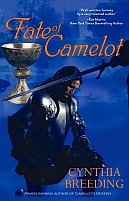|
|
BOOK
ILLUMINATIONS
From Medieval Book Reviews
HOME
ROMANCE
FICTION SUSPENSE & THRILLERS
MYSTERY
AUTHORS REVIEWER
PROFILES
|
Fate of Camelot

by Cynthia
Breeding

A treat for medieval Arthurian junkies
Cynthia
Breeding's FATE OF CAMELOT
focuses on the later days of
Camelot: the Grail Quest and King Arthur's healing at Avalon. Cynthia
Breeding reshapes the medieval Arthurian texts by returning to the
medieval texts themselves, history and modern scholarship. Using these
as a springboard for her imaginative vision of the last days, Cynthia
Breeding presents a vision of the more mysterious aspects of the
Arthurian legends. If a reader wants a romanticized and simplified
Hollywood version of Camelot, readers should turn elsewhere than the
tales of Cynthia Breeding. On the other hand, FATE OF CAMELOT will find
particular appeal to Arthurian junkies, especially those versed in the
medieval Arthurian literary traditions. Cynthia Breeding incorporates
the magical paranormal into FATE OF CAMELOT and yet her details are so
grounded in the medieval tradition, both of Arthurian romance as well
as the chronicle tradition (medieval historical writings), giving her
story both a historical and magical atmosphere.
The brilliance of Cynthia Breeding's writing in FATE OF CAMELOT
truly shines in her handling of the Grail Quest. By shifting the
placement of the Quest within the Arthurian time line, the quest makes
sense. In many medieval versions, the quest seems out of place and even
as a distraction from the kingdom which eventually leads to the
downfall of Camelot. In Cynthia Breeding's version, the Quest occurs
within the context of healing. Cynthia Breeding's portrait of Galahad
is one of the finest moments in this novel. Like Malory, she softens
the highly misogynist tone found in the French Vulgate cycle in LA
QUESTE DEL SAINT GRAAL, a text obsessively focused on the
concept of
chastity that women can only be seen as the enemy. Like Malory, Cynthia
Breeding focuses on the relationship of Galahad to his father Lancelot.
Cynthia Breeding explores this relationship even more deeply by taking
readers into the family relationships, an element that uses the modern
romance tradition to shed light on the medieval traditions. Cynthia
Breeding does not gloss over the misogyny of the Old French version but
rather she presents readers with a context that makes Galahad a more
fully developed character.
In FATE OF CAMELOT, Cynthia
Breeding develops the Arthur-Lancelot-
Gwenhwyfar relationship found in CAMELOT'S
DESTINY. In many Arthurian
tales, Guinevere is a rather flat character. Cynthia Breeding gives her
a depth of character as the reader sees both her love for Lancelot and
her devotion to the realm as its queen. The deep friendship between
Arthur and Lancelot seen in Malory's Arthurian tales becomes even more
pronounced. Cynthia Breeding is more faithful to the medieval Arthurian
tradition than a glamorized Hollywood version. She does not gloss over
the difficulties of the Gwenhwyfar's role as queen and as woman but
rather develops them to give the reader a vision of a woman who lives
her role as queen and lover with all that she is.
In her narrative style, Cynthia Breeding pays homage to the
medieval texts. Some modern readers might be thrown by her narrative
structure just because it is more authentic to the period than the
style of modern romance, but for me, it was part and parcel of the
brilliance of this book. My enjoyment of Cynthia Breeding's FATE OF
CAMELOT was heavily influenced by my previous reading history in
medieval Arthurian romance. I do not believe a reader has to have this
reading background to enjoy this story. Readers versed in the the
medieval traditions, however, will discover a special delight in the
more subtle nuances of this book, appreciating the author's impeccable
attention to the source material and her fictional imagination.
Publisher: Highland Press (July 2008)
Reviewed by Merrimon,
Medieval Book Reviews

|
|
|